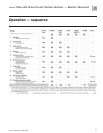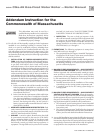
Part number 550-110-282/1108
40
GOLD
CGs-4E Gas-Fired Water Boiler — Boiler Manual
Service & maint. — annual start-up (continued)10b
❏ Check/test . . .
Gas piping
1. Sniffnearoorandaroundboilerareaforanyin-
dication of a gas leak.
2.
Test gas piping using bubble test,perSection5
of this manual, if there is any indication of a leak.
Cold fill and operating pressures
1. While the system is cold, note the pressure reading
ontheboilerpressure/temperaturegauge.Verifythat
cold fill pressure is correct.
2.
Watch the pressure as the boiler and system heat
up to ensure pressure rise is normal. Too high a rise
would indicate a waterlogged or undersized expan-
sion tank.
Air vents and air elimination
1. Inspectautomaticairvents(ifused).Alsoinspect
air separators to ensure they are operational.
2. The cap must be unscrewed one turn to allow air to
escape.
3. See
Figure 22. If the air vent is leaking, remove cap
A and briefly push valve B and then release to clean
the valve seat.
4. Replace cap
A by twisting all the way onto valve B
and then unscrewing one turn.
Figure 22 Automatic air vent, typical
Limit controls and cutoffs
1. Inspectandtesttheboilerlimitcontrol.Verifyop-
eration by turning control set point below boiler
temperature.Boilershouldcycleoff.Returndialto
original setting.
2. Inspect and test additional limit controls or low
water cutoffs installed on system.
Expansion tank
1. Expansiontanksprovidespaceforwatertomovein
an out as the heating system water expands due to
temperature increase or contracts as the water cools.
Tanks may be open, closed or diaphragm or bladder
type.SeeSection3 of this manual for suggested best
location of expansion tanks and air eliminators.
Open-type — located above highest radiator or
baseboard unit, usually in the attic or closet. Has a
gauge glass and overflow pipe to a drain.
Closed-type — welded gas tight and located above
boiler. Tank is partially filled with water, leaving an
air cushion for expansion.
• Makesurethistypeoftankisttedwitha
tank
tting
,suchastheB>ank-Trol or Taco
Taco-Trol. This fitting reduces gravity circula-
tion of air-saturated tank water back to the
system and prevents the air from bubbling up
through the water as it returns from the sys-
tem.
•
Do not use automatic air vents in systems
with closed-type tanks.
The air will escape
from the system instead of returning to the tank.
Eventually,thetankwillwaterlogandnolonger
control pressurization. The boiler relief valve
will weep frequently.
Diaphragm- or bladder-type — welded gas tight
with a rubber membrane to separate the tank pres-
surizingairandthewater.Maybelocatedatany
point in the system, but most often found near the
boiler.
• Systemswiththistypeofexpansiontankrequire
at least one
automatic air vent, preferably lo-
cated on top of an air eliminator, as shown in
examplesinmanualSection3.
2. If relief valve has tended to weep frequently, the ex-
pansion tank may be waterlogged or undersized.
Closed-type tank — tank is most likely water-
logged. Install a tank fitting if not already installed.
Then check fill level per fitting manufacturer’s
instructions. If fill level is correct, check tank size
against manufacturer’s instructions. Replace with
a larger tank if necessary.
Diaphragm- or bladder-type — first, check tank
size to be sure it is large enough for the system. If
size is too small, add additional tank(s) as neces-
sary to provide sufficient expansion. If tank size is
large enough, remove tank from system and check
charge pressure (usually 12 psig for residential ap-
plications). If tank won’t hold pressure, membrane
has been damaged. Replace tank.


















